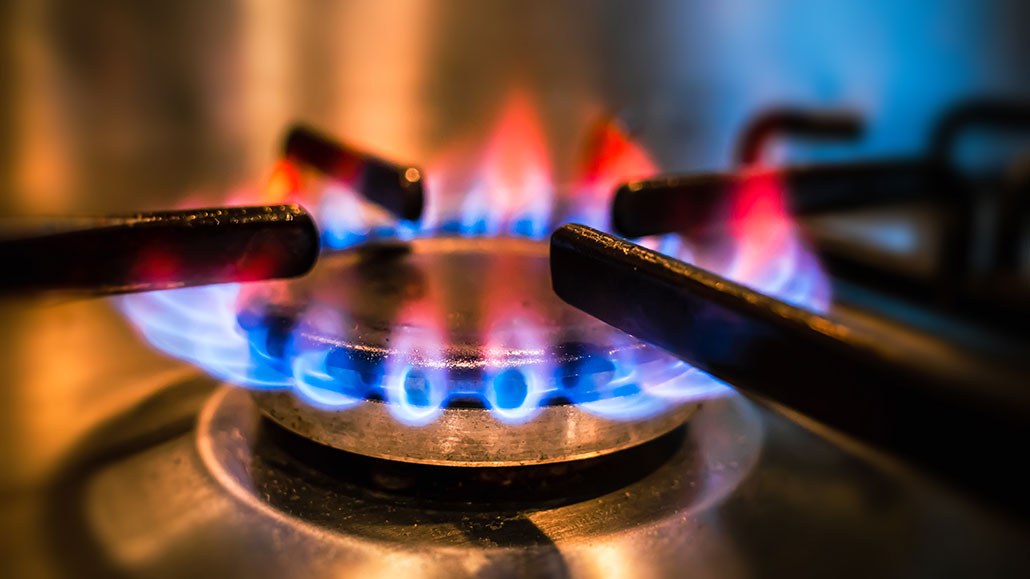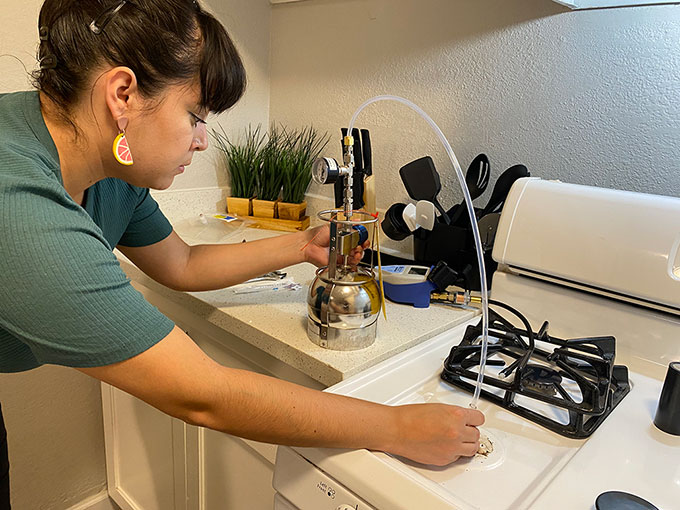Gas stoves can spew lots of pollution, even when they’re turned off
Some shed high levels of cancer-causing benzene into a home’s air, a new study shows

A new California study finds gas stoves frequently leak dangerous pollutants into kitchen air, including benzene, a cancer-causing chemical.
SEAN GLADWELL/Moment/Getty Images Plus
Share this:
- Share via email (Opens in new window) Email
- Click to share on Facebook (Opens in new window) Facebook
- Click to share on X (Opens in new window) X
- Click to share on Pinterest (Opens in new window) Pinterest
- Click to share on Reddit (Opens in new window) Reddit
- Share to Google Classroom (Opens in new window) Google Classroom
- Click to print (Opens in new window) Print
By Laura Allen
Drip, drip, drip. Most of us can see and hear a leaky faucet. But gas leaks can go undetected. In fact, they often do in the homes of people with gas stoves. And a new study found that gas can reach unhealthy levels indoors, even when the stoves are turned off.
Natural gas is a fossil fuel that develops in deposits deep within the Earth. Drilling companies often collect it through a technique known as fracking. Straight from the ground, natural gas will be mostly methane (CH4), along with a mix of other hydrocarbons and gases. Before it’s piped to homes and businesses, gas companies will remove most of the non-methane gases. Since methane has no odor, gas companies add a strong-scented chemical (it smells like rotten eggs) to alert people to possible leaks of this explosive gas.
“We know natural gas is mostly methane,” says Eric Lebel. “But we didn’t know what [other chemicals] were also in the gas.” He’s an environmental engineer who led the new study. He works for PSE Healthy Energy, a research group in Oakland, Calif.

“We thought the hazardous air pollutants would be removed in the processing [of the gas],” says mechanical engineer Kelsey Bilsback. She’s a coauthor at PSE Healthy Energy. To find out what pollutants might remain, her team collected samples from 159 gas stoves across California and sent them to a lab for analysis.
It turned up 12 hazardous air pollutants, they now report. Four of these gases — benzene, toluene, hexane and m- or p-xylene — were found in nearly every sample (more than 98 percent). Like methane, they are hydrocarbons.
The 12 pollutants flowed along with the methane being supplied to homeowners. Without a gas leak, no one should have been exposed to these gases — at least not when the stove wasn’t being used. However, a January 2022 study by Lebel’s team found that most gas stoves leak at least a little, even when they’re turned off. Small leaks may not give you a whiff of that rotten-egg smell. (If you ever do smell it, leave the building right away and call the gas company!) But if present, the leaks could still expose people to these harmful gases.
Tips to limit stove pollution
Have a gas stove? Wynne Armand offers these tips to keep your home safer. Armand, a primary care doctor at Massachusetts General Hospital, shared them on Harvard Medical School’s blog.
- Use windows and fans to get pollution outside when you cook. If you have an exhaust fan above your cooktop, always use it when the stove is on. If you don’t have one, open the windows (even a crack) while cooking whenever the weather permits.
- Use an air purifier. They don’t remove all pollutants, but they can improve indoor air quality.
- Switch to electric appliances when possible. Instead of heating water on the stove, use a plug-in kettle. Heat food in the microwave. Get a portable electric-induction cooktop to use on a countertop.
All natural gas is not the same
For its new study, this team analyzed the recipe of the natural gas that was being supplied to each stove. Then the researchers used information on the leak rates from the team’s earlier study. This allowed them to calculate how toxic the pollution was that was leaking into each home from its unlit stove.
They focused on benzene. Not only did this chemical show up in almost every case, but it also can cause cancer. When it comes to breathing, there are no safe levels of benzene, according to the World Health Organization.
“We found that when stoves are off and leaking, you can have harmful levels of benzene in the kitchen and home,” says Bilsback. In homes with bigger leaks, the benzene exposure was similar to that in secondhand cigarette smoke.
The amount of benzene in the gas being piped into homes varied a lot. Gas from some parts of southern California (the North San Fernando and Santa Clarita Valleys) had the most. Leaks in those homes could emit enough benzene to exceed limits set by the state for outdoor air. A June study by other scientists looked at natural-gas supplies delivered to homes around Boston, Mass. There, benzene levels were much lower. Most of the California gas contained around 10 times as much benzene as in Boston. One California sample had a whopping 66 times as much as the highest sample from Boston. More research is needed to identify how much the benzene levels in gas can vary from one source to another.
The PSE team notes that people are probably exposed to even more benzene than the new study reports. Each time a burner is turned on or off, even more gas leaks out. But the team didn’t include that in its new estimates.
Lebel and Bilsback’s team shared its findings Nov. 15, 2022, in Environmental Science and Technology.
Beyond benzene
There are more concerns than just the benzene findings, says Brett Singer. He’s an air-quality scientist at the Lawrence Berkeley National Laboratory in California. Many stoves leak small amounts of methane each time someone turns their burners on or off. Methane is a potent greenhouse gas. It’s 80 times more powerful than carbon dioxide at warming Earth’s atmosphere.
The flames from burners on a gas stove also cause chemical reactions between nitrogen and oxygen in the air, Singer points out. These reactions form other chemicals, such as nitrogen dioxide (NO2). That’s an irritant that can harm lung function in susceptible people, according to the American Lung Association. One 2013 study analyzed the results of 41 studies. It found that children living in homes with gas stoves faced a 42 percent increased risk of asthma symptoms. And a study published in December 2022 linked 12.7 percent of U.S. childhood asthma cases to living in homes that used gas stoves.
Scientists know that burning gas produces hazardous air pollutants, says Singer. This is why building codes require that gas water heaters and furnaces vent their emissions outdoors. But mostly, such rules exempt stoves. Some states do require exhaust fans for new homes, says Singer. But these fans have to be turned on and off manually. And he’s found that many people don’t bother. He encourages people to always use exhaust fans when a gas stove or oven is in use.
Electric ranges offer a less polluting alternative. A relatively new electric technology, known as an induction cooktop, uses magnetic fields to heat up cookware. It’s not only energy-efficient, but it also heats things faster than either gas or regular electric stovetops, says Lebel. This year, the U.S. government will offer rebates of up to $840 for electric and induction ranges, says Lebel. This greener cooking option not only reduces demand for a climate-warming fossil fuel, but also will offer cleaner indoor air.






